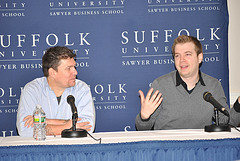Brands
7 Social Media Myths Debunked By Dan Zarella
Social media “scientist” Dan Zarella is a different kind of marketing guru. He eschews head-nodding maxims like “be part of the conversation” and puts commonly held notions to the test. With a mix of scientific method and just enough statistics to be dangerous, Zarella recently shared his own version of Mythbusters at the Inbound Marketing Summit (#ims11) in Boston, Ma.
Zarella debunked all 7 myths below using data collected from millions of Twitter and Facebook users, their status updates, and lots of math.
Myth #1: Engaging in the conversation is the most important thing on social media.
According to data, people with more followers have fewer conversations with other people on Twitter. But they do share a lot more links.
Conversely, people with fewer followers share fewer links and have more conversations.
“Engaging in the conversation doesn’t work,” Zarella explains, from a follower-building standpoint. “Publishing interesting content does.”
Myth #2: Don’t call yourself a guru on Twitter
Many people say that if you claim to be a guru on Twitter, that means you aren’t one. However, data shows that those who do so have more followers than the average Twitter user, and bios with the words “official” and “expert” tend to have even more followers.
“Don’t be afraid to identify yourself authoritatively,” says Zarella. There’s a correlation between this identification as an expert and follower count. But, of course, that doesn’t mean that by simply calling yourself a guru you will have more followers. You’ve got to back it up, too, or you’ll be unfollowed.
Myth #3: Fridays, Saturdays, and Sundays are bad days to publish
According to Zarella’s studies, email and social media link click-throughs are higher on Saturday and Sunday than during the week. That’s because total email and status update volume those days is lower. It’s like when everyone gets quiet right when you say something embarrassing at a party.
Facebook shares go way up on Saturday and Sunday, because that’s when people have time to share, and that’s when they’re not being bombarded by everyone else. “Use contra-competitive timing,” says Zarella. “It is exactly the moment when your competitors are quietest when you want to be loudest.”
Myth #4: Talk about what other people are talking about
Tweets with the most words in common get the lowest amount of retweets, according to Zarella’s stats. Word novelty analysis indicates that if you tweet something that no one else is saying, it’s more likely to be retweeted.
Zarella experimented on his blog with the fake retweet buttons, one with a hard coded “0 retweets” and one with several hundred alleged shares. His experiment resulted in more people sharing the posts with zero retweets than with hundreds.
“No one wants to be the 777th person to share something,” Zarella explains.
Myth #5: Saying “Please ReTweet” doesn’t work
Raw data speaks louder than naysayers do. Apparently by adding “Please ReTweet” to status updates, the average result is a 4-fold increase in retweets. It’s less if you abbreviate “Please RT” than if you spell it all the way out.
Calls to action work in 140 characters, too.
Myth #6: Quality (of followers) gets you more reach than quantity
According to Zarella’s science, having a lot of small-fry followers gets you more reach than having fewer followers who in turn have large followings. If you have to re-read that a couple of times to make sense of it, don’t worry. I did, too!
Myth #7: The more frequently you publish, the more followers you get
The click-through rate of links in status updates goes down with every additional tweet per hour. If you share just one link an hour, you’ll enjoy much more engagement with your links than if you share 10, 5, or even 2 links per hour. Oversharing apparently “cheapens” the value of your content in your followers minds.
Zarella says, “Don’t crowd out your own content.”
Perhaps Zarella’s goal to “get beyond the unicorns and rainbows myths and get into the science” of social media makes him an even geekier Mythbuster than the real Jamie and Adam (if that’s possible). We’ll debunk the myth that that’s a bad thing later.
Related articles
- Roundup of the Science of Social Media Webinar (webdesignfromscratch.com)
- How To Get More Tweets (And Retweets) (smallbusinessmavericks.com)
- 4 Ways to Increase Your Social Media Reach (seopositive.co.uk)
- Reviewing Dan Zarrella’s latest social media book: Zarrella’s Hierarchy of Contagiousness (thenextweb.com)
Get better at your job right now.
Read our monthly newsletter to master content marketing. It’s made for marketers, creators, and everyone in between.





